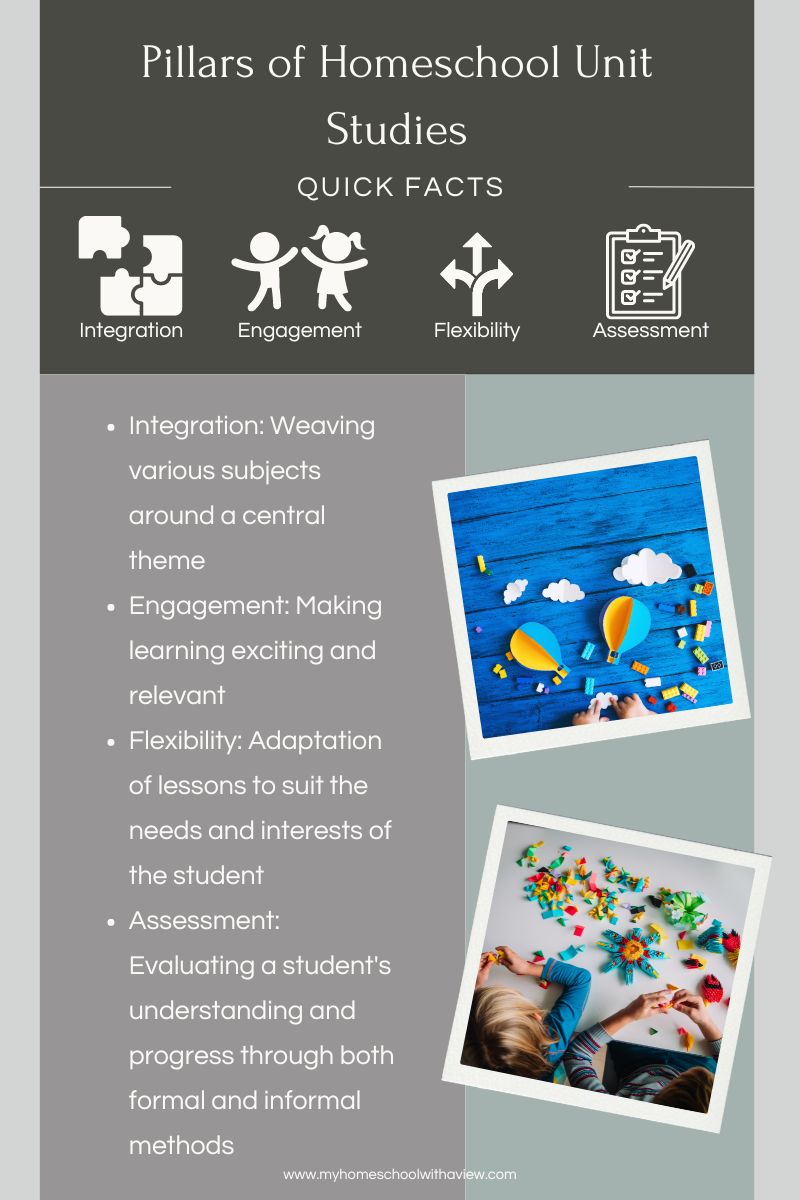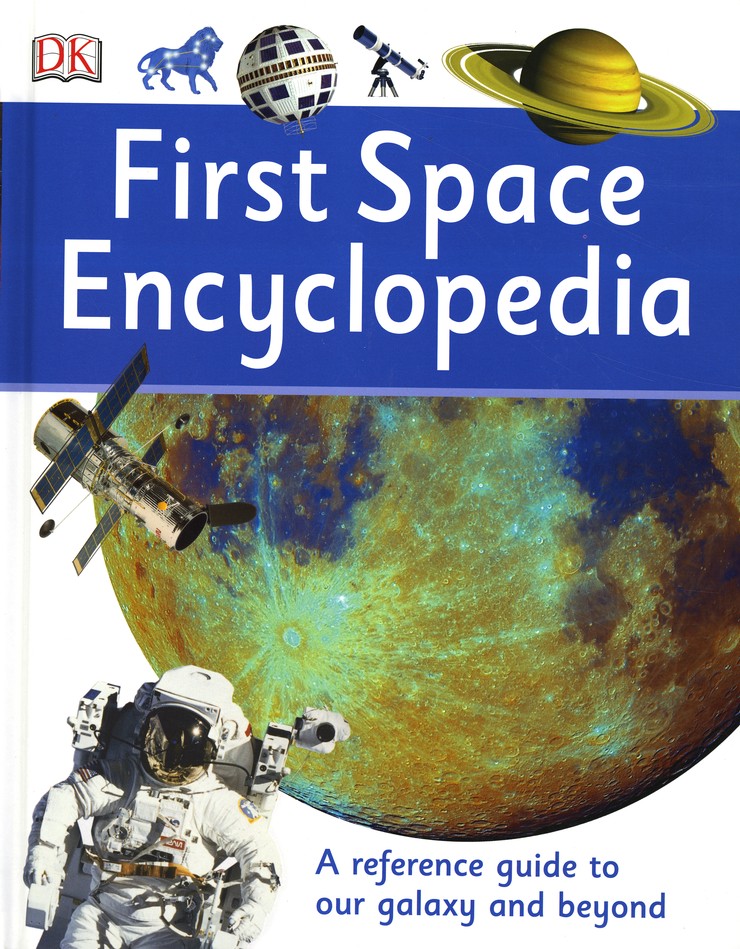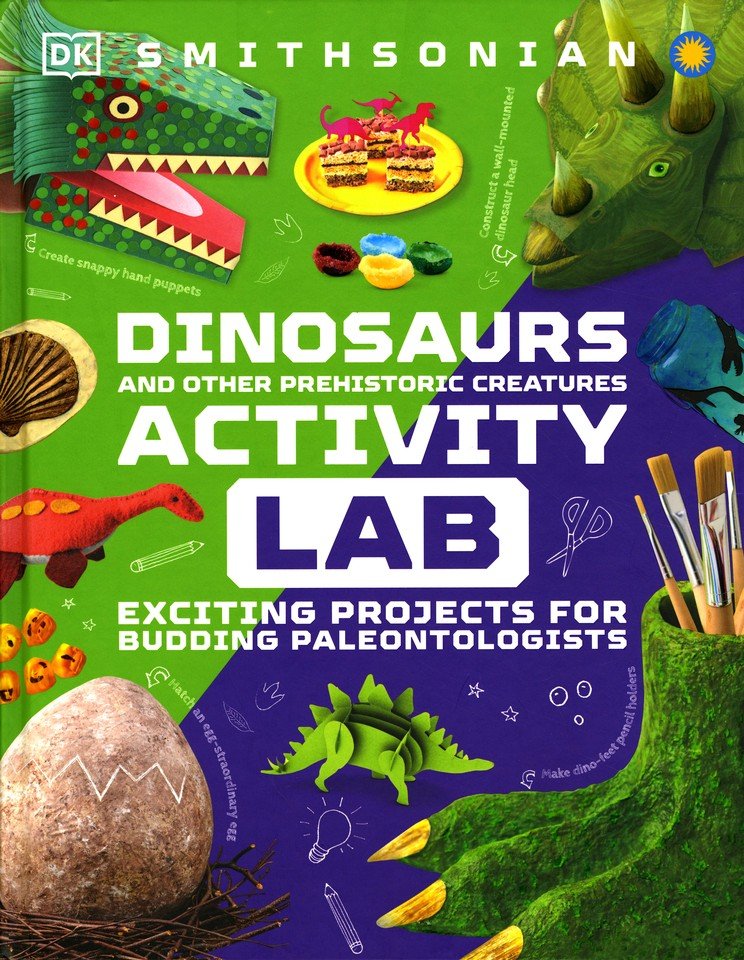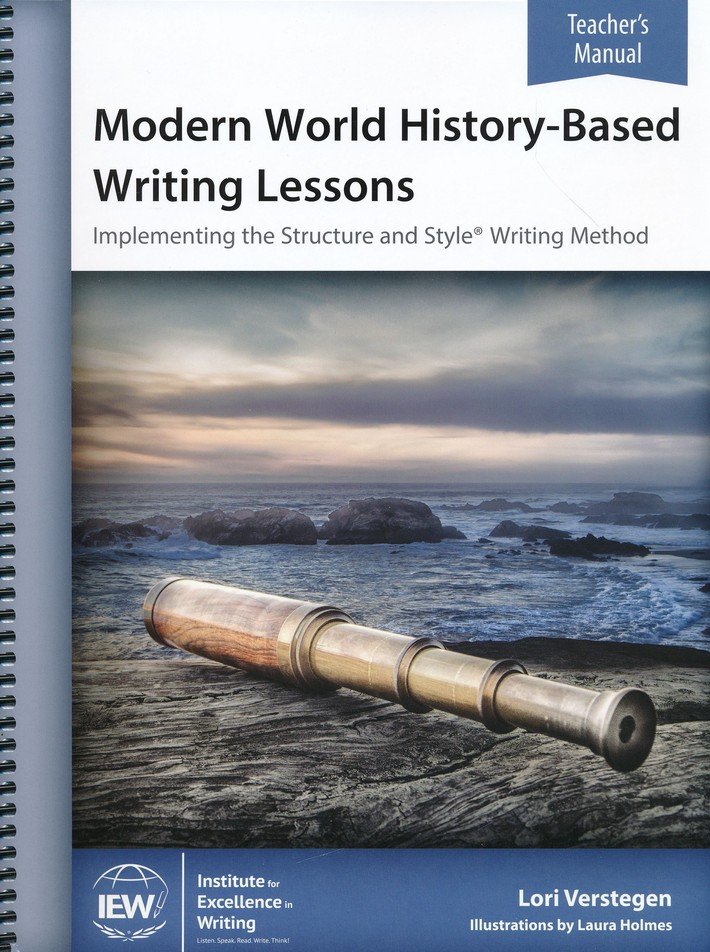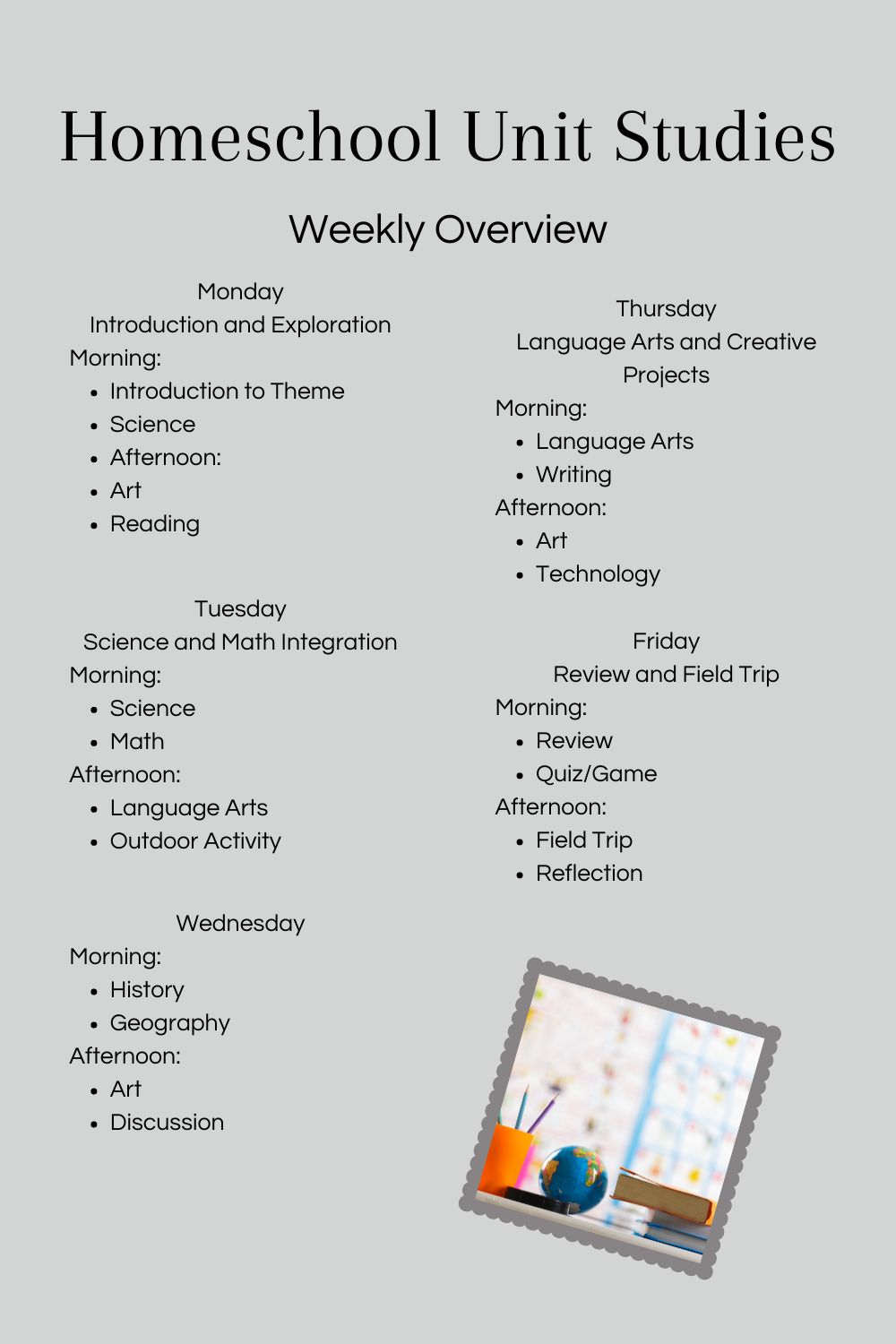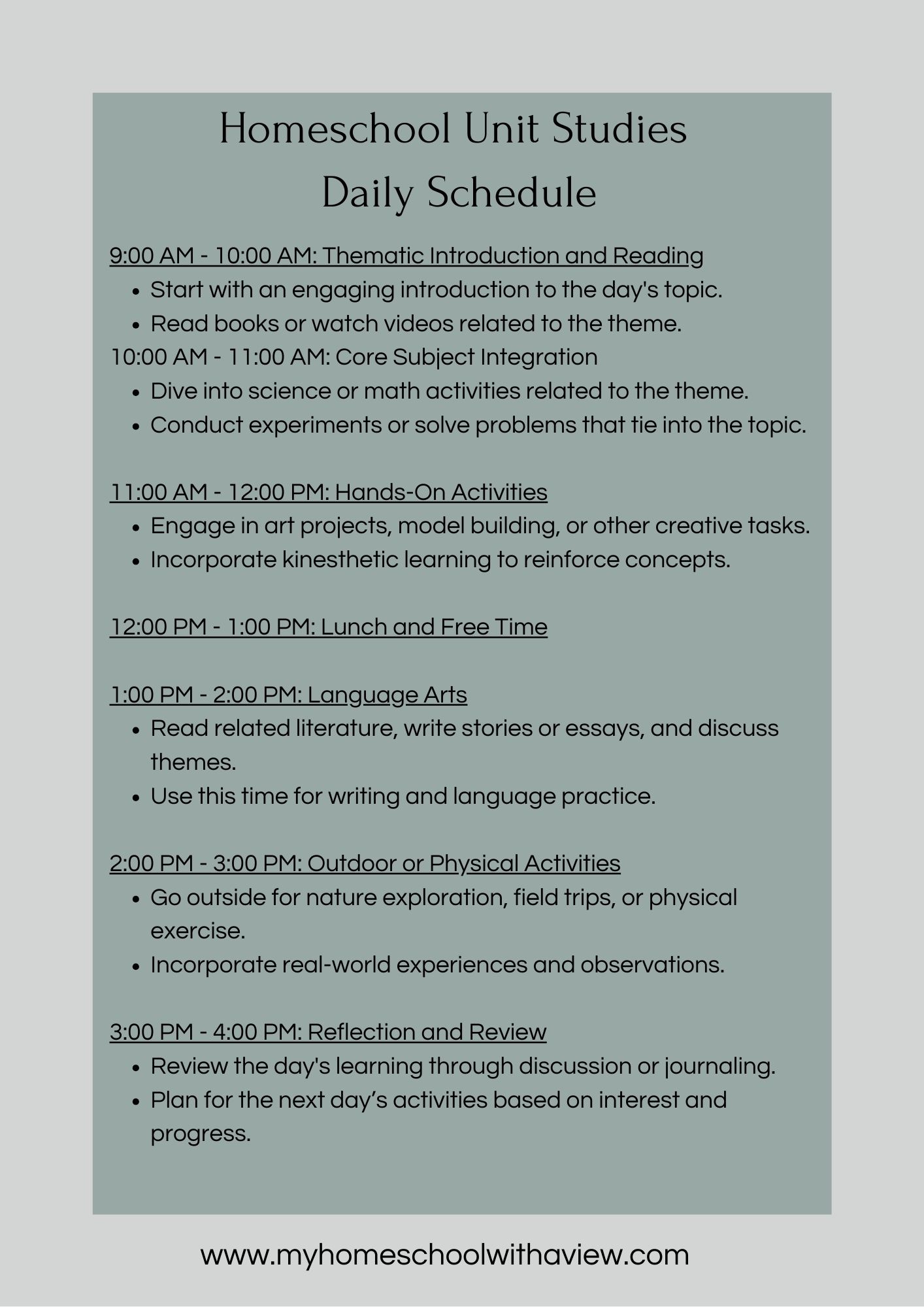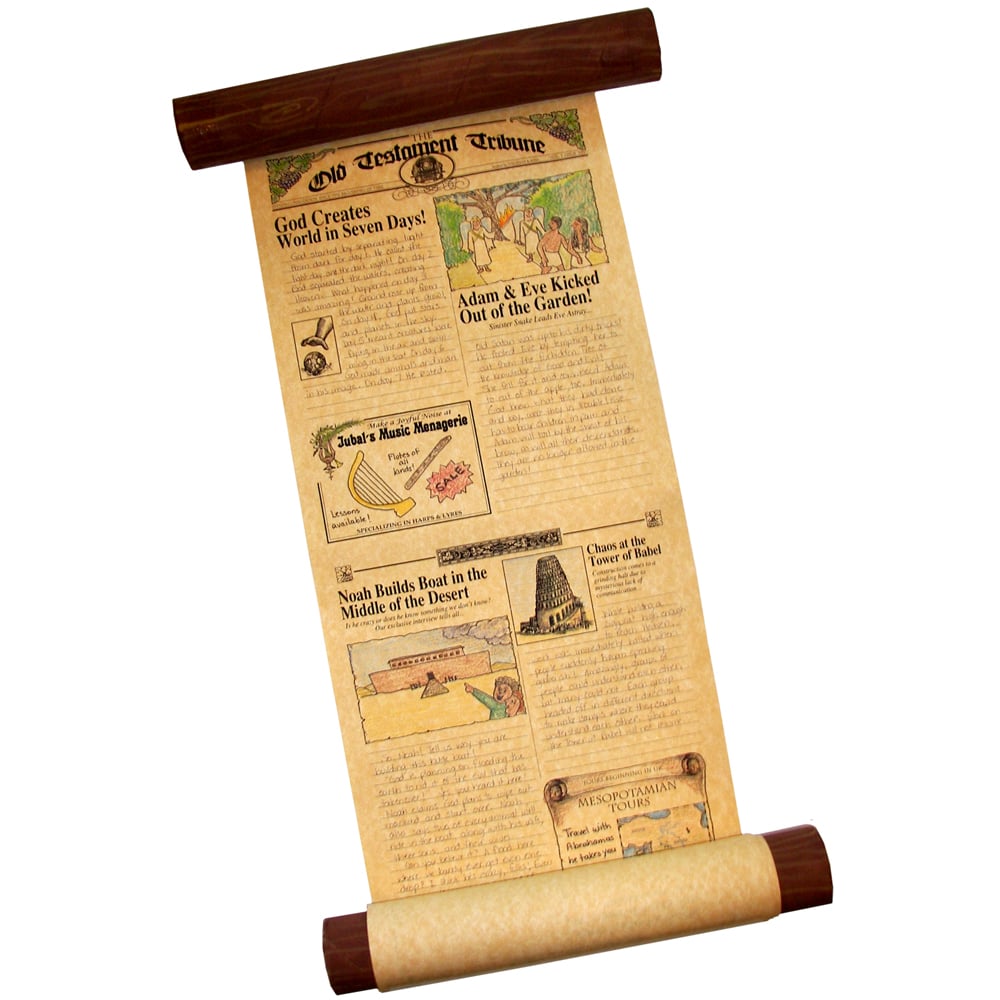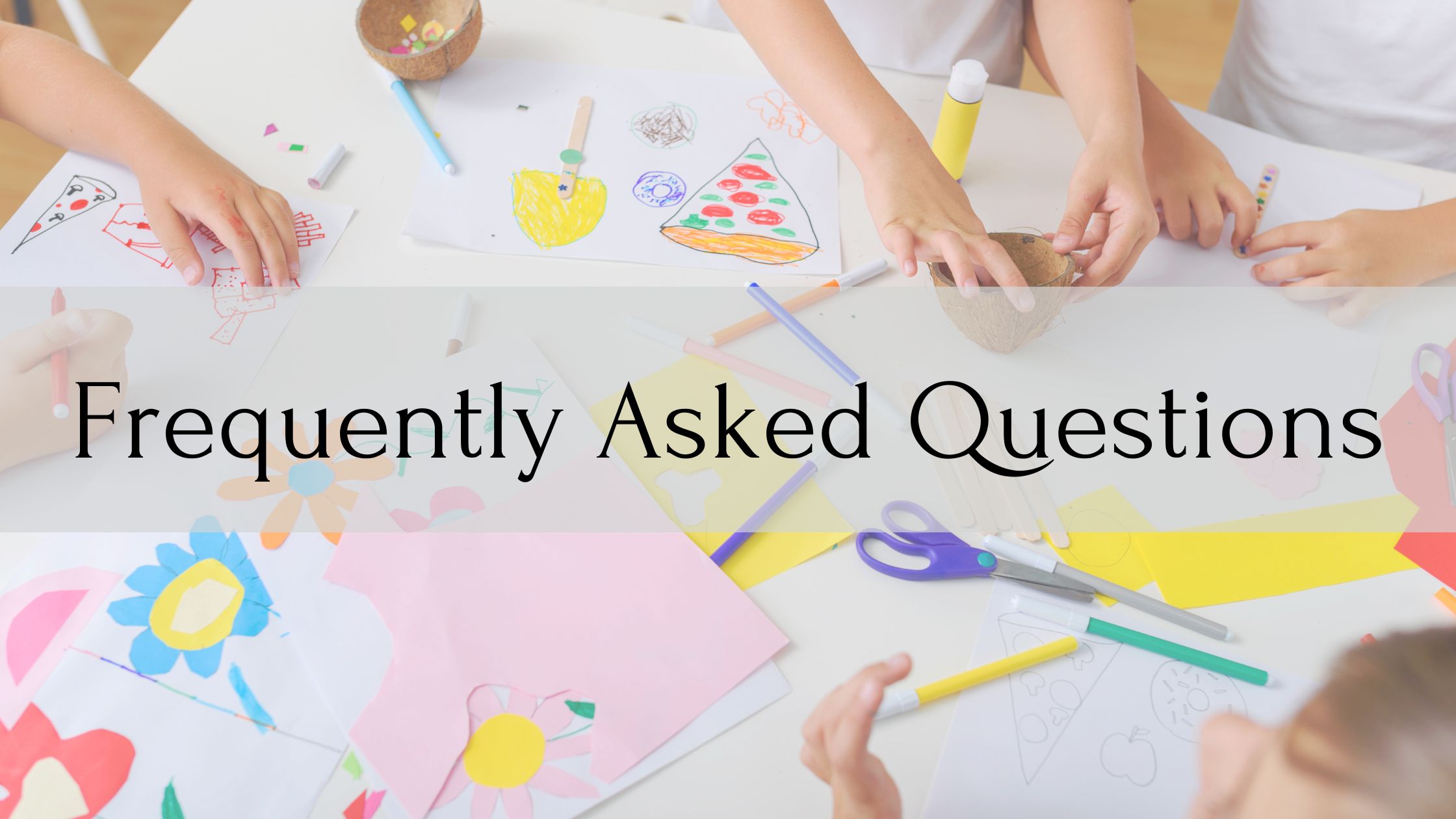This post is all about homeschool unit studies.
Among all of the homeschool styles and methods, homeschool unit studies stand out as a fun approach to daily learning. By integrating multiple subjects around a central theme, unit studies can make learning more cohesive and engaging for your child.
Before I began homeschooling, if you asked me to paint a picture of the perfect homeschool experience, homeschool unit studies would be my method of choice. Like so many others, I had no idea where to begin with homeschool unit studies. A guide like this is exactly what I needed, so I am creating it for you.
Whether you are new to homeschooling or looking to spice up your current routine, this guide will give you a better understanding of homeschool unit studies, benefits and tips to implement homeschool unit studies.
This post contains affiliate links and My Homeschool with a View, LLC participates in the Amazon Associates program. If you make a qualifying purchase through our links, we earn a commission at no additional cost to you . Thank you for supporting this site! You can read my affiliate and advertising disclosure here.
What are Homeschool Unit Studies?
Homeschool unit studies are a method of teaching that integrates multiple subjects around a central theme, making learning both cohesive and engaging.
Instead of teaching subjects like math, science, history, and language arts in isolation, unit studies combine them under one umbrella topic. This method allows children to make connections between different areas of learning, fostering a deeper understanding of the material.
Unit studies have their roots in the progressive education movement of the early 20th century, which emphasized the importance of experiential learning and student-centered instruction. Today, they are a popular choice among homeschooling families for their flexibility and effectiveness.
Benefits of Unit Studies in Homeschooling
Unit studies offer several key benefits:
- Integrated Learning: By connecting different subjects, children see how knowledge is interrelated.
- Engagement: Themes based on interests can make learning more exciting.
- Flexibility: You can tailor the study to your child’s pace and interests.
- Critical Thinking: Students develop problem-solving skills as they explore topics in depth.
The 4 Pillars of Homeschool Unit Studies
Unit studies are grounded in four key pillars that ensure a comprehensive and effective learning experience: integration, engagement, flexibility, and assessment. Understanding and implementing these pillars can help you create a well-rounded and successful homeschooling approach.
1. Integration
Integration involves weaving various subjects around a central theme, allowing for a multidisciplinary approach to learning.
- Why It’s Important: By integrating subjects, students can see how different areas of knowledge connect and relate to each other, fostering a more holistic understanding.
- How to Implement: Choose a central theme and brainstorm how different subjects can be incorporated. For example, in a unit study on Ancient Egypt:
- Science: Study the engineering behind the pyramids.
- Math: Explore the mathematical concepts used in Egyptian architecture.
- History: Learn about the daily life, culture, and significant events of Ancient Egypt.
- Language Arts: Read myths and write essays or stories related to Ancient Egypt.
- Art: Create Egyptian-style art projects.
2. Engagement
Engagement focuses on making learning exciting and relevant, encouraging students to actively participate in their education.
- Why It’s Important: When students are engaged, they are more likely to retain information, develop critical thinking skills, and foster a love for learning.
- How to Implement: Use a variety of interactive and hands-on activities to keep students interested.
- Field Trips: Visit museums, science centers, or historical sites related to the unit study theme.
- Projects: Incorporate creative projects such as building models, creating art, or conducting experiments.
- Technology: Utilize educational apps, videos, and virtual tours to bring topics to life.
3. Flexibility
Flexibility allows for the adaptation of lessons to suit the needs and interests of the student, making learning personalized and dynamic.
- Why It’s Important: Flexibility ensures that learning is tailored to the student’s pace, interests, and learning style, making education more effective and enjoyable.
- How to Implement: Be prepared to adjust your plans based on your child’s responses and interests.
- Diving Deeper: If a particular aspect of the theme fascinates your child, spend more time exploring it.
- Shifting Gears: If a topic isn’t resonating, pivot to another area or find a different approach.
- Pacing: Slow down for challenging topics and accelerate for areas where your child excels.
4. Assessment
Assessment involves evaluating a student’s understanding and progress through both formal and informal methods.
- Why It’s Important: Regular assessment helps track progress, identify areas of improvement, and ensure that educational goals are being met.
- How to Implement: Use a variety of assessment tools to gauge learning.
- Projects and Presentations: Have students create projects or give presentations on what they’ve learned.
- Quizzes and Tests: Use quizzes and tests to assess knowledge in a structured way.
- Observation and Discussion: Engage in regular discussions and observe your child’s engagement and comprehension during activities.
- Portfolios: Compile a portfolio of your child’s work to document progress over time.
Example: Applying the 4 Pillars in a Unit Study on Space Exploration
Integration:
- Science: Study the solar system, planets, and space travel technology.
- Math: Calculate distances between planets and understand the mathematics of orbits and trajectories.
- History: Learn about the history of space exploration, including key missions and astronauts.
- Language Arts: Read science fiction stories and write essays or reports on space-related topics.
- Art: Create models of the solar system or design a spacecraft.
Engagement:
- Field Trips: Visit a planetarium or science museum with space exhibits.
- Projects: Build a model rocket or create a diorama of the solar system.
- Technology: Use space simulation apps or watch documentaries about space missions.
Flexibility:
- Diving Deeper: If your child is particularly interested in Mars, spend extra time studying its geology, potential for life, and future exploration missions.
- Shifting Gears: If space technology isn’t engaging, pivot to studying stars and constellations or the mythology behind them.
- Pacing: Take more time with complex topics like orbital mechanics and move faster through areas your child quickly grasps.
Assessment:
- Projects and Presentations: Have your child create a project on their favorite planet or a famous space mission and present it to the family.
- Quizzes and Tests: Use quizzes to test knowledge on the solar system and space facts.
- Observation and Discussion: Discuss daily what your child found most interesting and challenging.
- Portfolios: Keep a portfolio of drawings, reports, and projects to track progress and achievements.
Why Choose Unit Studies for Homeschooling?
Choosing unit studies for your homeschool curriculum can bring a myriad of benefits, from fostering a love of learning to enhancing critical thinking skills. Unit studies allow you to create a personalized learning experience that keeps your child engaged and motivated.
Personalized Homeschooling
One of the greatest advantages of unit studies is the ability to tailor the curriculum to your child’s interests and learning style. This personalized approach ensures that learning is both engaging and effective, as it taps into your child’s natural curiosity and enthusiasm.
For example, if your child loves dinosaurs, you can create an entire unit study around paleontology. Here’s how you can incorporate various subjects into this theme:
Science
- Fossil Formation: Teach your child about how fossils are formed. Conduct experiments using clay and small objects to simulate fossilization processes.
- Dinosaur Anatomy: Study the anatomy of different dinosaur species. Use diagrams and models to compare their skeletal structures and understand how they moved and lived.
- Extinction Theories: Explore the different theories about why dinosaurs became extinct. Discuss concepts like meteor impacts and volcanic activity, and conduct simple experiments to demonstrate these ideas.
Reading
- Dinosaur Books: Provide a variety of books on dinosaurs, ranging from picture books for younger children to more detailed non-fiction for older students. Titles like “National Geographic Little Kids First Big Book of Dinosaurs” or “Dinosaurs Before Dark” from the Magic Tree House series can be great choices.
- Research Projects: Assign your child to read about different dinosaurs and present their findings. They can create a booklet or presentation about their favorite dinosaur, including facts about its habitat, diet, and physical characteristics.
Writing
- Creative Writing: Encourage your child to write a story set in the time of the dinosaurs. They could write from the perspective of a dinosaur or as a young paleontologist on a discovery adventure.
- Reports and Essays: Have your child write a report on a specific dinosaur or an aspect of paleontology. This exercise helps develop research and writing skills.
Math
- Measuring Dinosaurs: Use math to measure and compare the sizes of different dinosaurs. Create a life-sized outline of a dinosaur in your backyard or a large open space, and use measurement tools to bring math concepts to life.
- Dinosaur Data: Analyze data related to dinosaurs, such as the average length or weight of various species. Create charts and graphs to visualize this data, and use statistical methods to interpret it.
- Dinosaur Puzzles: Solve math puzzles and word problems that incorporate dinosaur facts. For instance, “If a Triceratops has three horns and there are four Triceratops in a herd, how many horns are there in total?”
Art
- Dinosaur Drawings: Draw and color pictures of different dinosaurs. Study the textures and patterns found on dinosaur fossils and attempt to recreate them in art projects.
- Clay Models: Sculpt clay models of dinosaurs, focusing on anatomical accuracy. This hands-on activity can help children better understand dinosaur anatomy.
- Dioramas: Create a diorama depicting a prehistoric scene. Include models of dinosaurs, plants, and landscape features to bring the past to life.
History and Geography
- Geological Time Scale: Study the geological time scale to understand when dinosaurs lived. Create a timeline that includes major events in Earth’s history.
- Dinosaur Discoveries: Research famous paleontologists and significant dinosaur discoveries. Map out where these discoveries were made and discuss how they have contributed to our understanding of prehistoric life.
- Ancient Earth: Learn about the different periods in which dinosaurs lived, such as the Triassic, Jurassic, and Cretaceous periods. Discuss the climatic and geographical changes that occurred during these times.
Flexibility and Adaptability
HomesUnit studies offer the flexibility to adapt your lessons as needed. This adaptability is one of the key strengths of this educational approach, allowing you to respond to your child’s interests and needs in real time. This means you can maximize engagement and learning by focusing on what excites your child and steering away from what doesn’t.
Diving Deeper into Interests
If your child becomes fascinated by a particular aspect of the topic, you have the freedom to explore that area more thoroughly. Here are some ways to capitalize on your child’s burgeoning interests:
Example: Astronomy Unit Study
- Fascination with Black Holes:
- Science: Dive deep into the science of black holes. Explore how they are formed, their properties, and the theories surrounding them. Watch documentaries and use simulations to understand their behavior.
- Math: Calculate the gravitational pull of a black hole and understand the concept of escape velocity. Use math to comprehend the massive scales involved in space phenomena.
- Reading: Provide books and articles about black holes, both fiction and non-fiction. Read biographies of scientists like Stephen Hawking who have contributed to our understanding of black holes.
- Writing: Encourage your child to write a science fiction story set near a black hole, or have them write a report on the latest black hole discoveries.
- Art: Create artwork depicting black holes, including their event horizons and the surrounding space. Use various mediums like drawing, painting, or digital art.
Example: Homeschool Unit Studies History
- Interest in Ancient Egypt:
- History: Study the daily life, culture, and politics of Ancient Egypt in greater depth. Explore topics like the construction of the pyramids, the significance of the Nile River, and the reign of famous pharaohs.
- Science: Investigate the technology and engineering behind pyramid construction. Conduct experiments to understand the principles they used.
- Math: Use Egyptian numerals and practice math problems as the ancient Egyptians did. Explore geometry through the design of pyramids.
- Reading: Read myths and stories from Ancient Egyptian culture. Include both historical texts and historical fiction to provide a broad perspective.
- Writing: Write diary entries from the perspective of an Ancient Egyptian child. Create reports or essays on specific topics like mummification or Egyptian gods and goddesses.
- Art: Create Egyptian-style art projects, such as painting hieroglyphs, building a model of a pyramid, or crafting jewelry inspired by Ancient Egyptian designs.
Shifting Gears When Needed
Conversely, if a subject isn’t resonating with your child, you can quickly shift gears. This flexibility ensures that learning remains enjoyable and effective:
Example: Ocean Exploration Unit Study
- Loss of Interest in Marine Biology:
- Pivot to Nautical Technology:
- Science: Shift focus to the technology used in ocean exploration, such as submarines and underwater drones. Study the physics of buoyancy and underwater propulsion.
- Math: Engage in projects that involve measuring and designing model submarines or boats. Solve problems related to distance, speed, and depth.
- Reading: Read books and articles about famous explorers and the technology they used. Include stories of underwater adventures and discoveries.
- Writing: Write a report on the evolution of underwater exploration technology or create a fictional story about a modern-day underwater explorer.
- Art: Build models of submarines or create blueprints for underwater exploration vehicles. Draw diagrams of the technology used in deep-sea exploration.
- Pivot to Nautical Technology:
Example: Homeschool Literature Unit Studies
- Disinterest in a Specific Book:
- Switch to a New Genre or Author:
- Reading: If a historical novel isn’t engaging, try a fantasy or science fiction book. Choose a book series that aligns more closely with your child’s interests.
- Writing: Encourage creative writing inspired by the new book. Have your child write alternate endings or new adventures for the characters.
- Science: Connect the new book to scientific concepts. For a fantasy book, explore the science behind mythical creatures or magical phenomena.
- Art: Create artwork based on the new story, such as character illustrations, maps of fictional worlds, or comic strips.
Tailoring the Pace
Encouraging Deep Learning and Exploration
Unit studies transform learning into an exhilarating adventure, where children are not just passive recipients of information but active explorers of knowledge.
This immersive approach encourages them to delve deep into topics, asking questions, conducting experiments, and seeking answers.
By embracing curiosity and inquiry, children develop critical thinking skills and a thirst for knowledge that extends far beyond the confines of the classroom.
This exploration-centric approach nurtures a lifelong love of learning, instilling in children a sense of wonder and excitement about the world around them.
Instead of simply memorizing facts and figures, children engage with concepts on a deeper level, making connections, drawing conclusions, and applying their understanding to real-world situations.
Whether they’re dissecting a frog to learn about biology, recreating historical events through role-play, or conducting experiments to understand scientific principles, unit studies empower children to become active participants in their own education, setting them on a path of discovery and growth that lasts a lifetime.
Homeschool Unit Study Planner
Planning a unit study may seem daunting at first, but with a few simple steps, you can create an engaging and effective learning experience for your child.
Choosing a Theme
Start by selecting a central theme that interests your child. The beauty of unit studies lies in their flexibility and the ability to center them around virtually any topic. This personalized approach ensures that learning is not only educational but also engaging and fun. Here are some theme ideas to spark your imagination and cater to a variety of interests:
Homeschool Unit Study Ideas
Outer Space
- Why It’s Engaging: The vastness and mystery of space captivate the imagination, offering endless opportunities for exploration and discovery.
- Activities:
- Science: Study the solar system, learn about stars and galaxies, and explore the physics of space travel.
- Math: Calculate distances between planets, learn about orbital mechanics, and solve problems involving space missions.
- Art: Create a model of the solar system, design your own space mission patch, or paint a starry night sky.
- History: Research the history of space exploration, from the first moon landing to current missions to Mars.
- Language Arts: Read science fiction stories, write essays on the future of space travel, or create a fictional story set in space.
2. Ancient Egypt
- Why It’s Engaging: The rich history, mythology, and achievements of ancient Egypt provide a fascinating glimpse into one of the world’s earliest civilizations.
- Activities:
- History: Learn about pharaohs, pyramids, and the daily life of ancient Egyptians.
- Science: Study the engineering marvels of the pyramids and the science behind mummification.
- Math: Explore the mathematics used in Egyptian architecture and hieroglyphic counting systems.
- Art: Create Egyptian-style art, such as hieroglyphic writing, jewelry making, or pyramid models.
- Language Arts: Read myths and legends from ancient Egypt, write diary entries from the perspective of an Egyptian child, or research famous archaeological discoveries.
3. Cooking
- Why It’s Engaging: Cooking combines creativity, science, and practical skills, making it a hands-on and delicious way to learn.
- Activities:
- Science: Explore the chemistry of cooking, such as how heat changes food, or the science behind baking bread.
- Math: Practice measurements, conversions, and fractions while following recipes.
- Geography: Learn about foods from different cultures and countries, and explore the history of various cuisines.
- Language Arts: Write your own recipes, create a cookbook, or read stories related to food and cooking.
- Art: Design and decorate cakes or cookies, create food-related art, or photograph culinary creations.
4. Coding and Technology
- Why It’s Engaging: In our digital age, understanding coding and technology opens up a world of opportunities and fosters logical thinking.
- Activities:
- Math: Use coding to reinforce math concepts like patterns, sequences, and problem-solving.
- Science: Learn about the technology behind computers and the internet, or explore robotics.
- Language Arts: Write code documentation, create a blog about your coding projects, or read books on famous tech innovators.
- Art: Design and build a website, create digital art, or develop your own video game.
- History: Research the history of computers and the internet, and study influential figures in the tech industry.
5. Environmental Science
- Why It’s Engaging: Understanding our planet and how to protect it is crucial for future generations, making this a timely and impactful theme.
- Activities:
- Science: Study ecosystems, climate change, and renewable energy sources.
- Math: Analyze data on environmental issues, such as carbon footprints or water usage.
- Geography: Learn about different biomes and the environmental challenges they face.
- Language Arts: Write essays on conservation efforts, create posters advocating for environmental causes, or read books about nature and wildlife.
- Art: Create recycled art projects, design nature-themed artwork, or illustrate the impact of pollution and conservation efforts.
6. Famous Artists and Their Art
- Why It’s Engaging: Art history introduces children to diverse styles, techniques, and cultural contexts, inspiring creativity and appreciation for visual expression.
- Activities:
- History: Study the lives and works of famous artists like Leonardo da Vinci, Frida Kahlo, or Vincent van Gogh.
- Science: Explore the chemistry of pigments and the physics of light and color.
- Math: Examine geometric patterns in art, such as those used by M.C. Escher, or study proportions and symmetry.
- Language Arts: Write biographies of artists, analyze art critiques, or create your own art-inspired stories.
- Art: Recreate famous artworks, experiment with different art techniques, or curate a mini art exhibit at home.
Setting Objectives and Goals
Outline what you hope to achieve with the unit study. What key concepts and skills do you want your child to learn? Setting clear objectives will help guide your planning and ensure that your unit study is educationally robust.
Integrating Multiple Subjects
Think about how you can incorporate various subjects into your theme. For example, a unit study on oceans might include:
- Science: Marine biology and ecosystems
- Geography: Mapping the world’s oceans
- History: The age of exploration
- Language Arts: Reading and writing about sea adventures
- Math: Calculating distances and depths
Gathering Resources and Materials
Collect the resources you’ll need, such as books, websites, videos, and hands-on materials. Don’t forget to consider local resources like museums, nature centers, and community experts who can provide additional learning opportunities.
Implementing a Homeschool Unit Study
With your unit study plan in hand, it’s time to bring your educational vision to life through engaging and interactive activities.
Daily and Weekly Schedules
Create a flexible schedule that outlines what you’ll cover each day and week. This will help you stay on track while allowing for spontaneity and exploration. Remember, the goal is to make learning fun and meaningful, not rigid.
Here’s how you can structure your daily and weekly schedules to ensure a well-rounded and enjoyable learning experience.
Example of a Weekly Schedule
Monday: Introduction and Exploration
- Morning:
- Introduction to Theme: Present the unit study theme. For instance, if the theme is “Oceans,” start with an engaging video or story about ocean exploration.
- Science: Discuss the different ocean zones. Use diagrams and pictures to illustrate.
- Afternoon:
- Art: Create a large mural of the ocean zones on a poster board. Add drawings or pictures of marine life found in each zone.
- Reading: Read a chapter from a book about marine animals.
Tuesday: Science and Math Integration
- Morning:
- Science: Conduct an experiment on ocean currents using a large container of water, food coloring, and ice cubes.
- Math: Graph the temperatures of different ocean currents. Discuss how currents affect climate and marine life.
- Afternoon:
- Language Arts: Write a summary of what was learned about ocean currents and their importance.
- Outdoor Activity: Visit a local body of water, if possible, and observe the currents and any wildlife.
Wednesday: History and Geography
- Morning:
- History: Learn about famous ocean explorers like Jacques Cousteau and Captain James Cook. Watch a documentary or read an article about their contributions.
- Geography: Map the routes taken by these explorers. Use a world map to trace their journeys.
- Afternoon:
- Art: Create a timeline of ocean exploration with illustrations and important dates.
- Discussion: Talk about the impact of these explorations on our understanding of the ocean.
Thursday: Language Arts and Creative Projects
- Morning:
- Language Arts: Read excerpts from ocean-themed books, like “20,000 Leagues Under the Sea.” Discuss the literary elements and themes.
- Writing: Begin drafting a short story set in the ocean. Encourage creativity and descriptive language.
- Afternoon:
- Art: Design and build a simple model of a submarine using household materials.
- Technology: Use an educational app to simulate an underwater exploration.
Friday: Review and Field Trip
- Morning:
- Review: Recap the week’s lessons. Discuss what was learned and what activities were most enjoyable.
- Quiz/Game: Have a fun quiz or game to reinforce key concepts. Use flashcards or an interactive online quiz.
- Afternoon:
- Field Trip: Visit a local aquarium or marine science center. Observe the marine life and participate in any educational programs offered.
- Reflection: Write a journal entry about the field trip experience, noting any new insights or favorite moments.
Example of a Daily Schedule
9:00 AM – 10:00 AM: Thematic Introduction and Reading
- Start with an engaging introduction to the day’s topic.
- Read books or watch videos related to the theme.
10:00 AM – 11:00 AM: Core Subject Integration
- Dive into science or math activities related to the theme.
- Conduct experiments or solve problems that tie into the topic.
11:00 AM – 12:00 PM: Hands-On Activities
- Engage in art projects, model building, or other creative tasks.
- Incorporate kinesthetic learning to reinforce concepts.
12:00 PM – 1:00 PM: Lunch and Free Time
1:00 PM – 2:00 PM: Language Arts
- Read related literature, write stories or essays, and discuss themes.
- Use this time for writing and language practice.
2:00 PM – 3:00 PM: Outdoor or Physical Activities
- Go outside for nature exploration, field trips, or physical exercise.
- Incorporate real-world experiences and observations.
3:00 PM – 4:00 PM: Reflection and Review
- Review the day’s learning through discussion or journaling.
- Plan for the next day’s activities based on interest and progress.
Tips for Creating Flexible Homeschool Schedules
- Incorporate Breaks:
- Schedule regular breaks to keep your child refreshed and focused.
- Be Ready to Pivot:
- If an activity sparks great interest, allow time to explore it further.
- Include Variety:
- Mix different types of activities to cater to various learning styles and keep things exciting.
- Plan for Downtime:
- Schedule some unstructured time for free play or quiet reading to balance structured learning.
Hands-On Activities and Experiments
Incorporate hands-on activities to make the learning experience more engaging. This approach brings lessons to life and helps children understand concepts in a tangible and memorable way. By actively participating in their learning, children are more likely to retain information and develop a deeper interest in the subject matter.
For example, if you’re studying plants, you might conduct experiments on seed germination, create a garden, or visit a botanical garden. Here are some additional ideas to enhance your unit studies with hands-on activities:
Seed Germination Experiment
- Setup: Provide seeds, soil, and containers for planting. Discuss the conditions necessary for germination, such as water, light, and temperature.
- Experiment: Plant seeds in different conditions to observe how they affect growth. For instance, place some seeds in a sunny spot and others in a darker area. Water some regularly while leaving others dry.
- Observation: Have your child record daily observations, noting differences in growth patterns. Measure the height of plants, count leaves, and document any changes.
- Analysis: Discuss the results and draw conclusions about the best conditions for seed germination. This hands-on experiment reinforces scientific concepts and critical thinking.
Creating a Garden
- Planning: Involve your child in planning a garden. Choose plants, design the layout, and research the needs of each plant type.
- Planting: Teach your child how to prepare the soil, plant seeds or seedlings, and care for the garden. Assign regular tasks such as watering, weeding, and monitoring plant health.
- Harvesting: When the plants mature, harvest the produce together. Discuss the life cycle of plants and the importance of sustainable gardening practices.
- Integration: Use the garden to integrate other subjects. For example, measure plant growth for math practice, write a journal documenting the gardening process for language arts, or study the biology of plant life cycles.
Visiting a Botanical Garden
- Field Trip: Plan a visit to a local botanical garden. Before the visit, research the types of plants you’ll see and make a list of key questions to explore.
- Guided Tour: Take a guided tour if available, or use informational signs and brochures to learn about different plant species, ecosystems, and conservation efforts.
- Interactive Learning: Encourage your child to take photos, make sketches, and take notes during the visit. Discuss what you learned and how it relates to your studies at home.
- Follow-Up Activities: After the visit, create a project based on your findings. This could be a scrapbook of collected materials, a report on specific plants, or an art project inspired by the botanical garden.
Additional Hands-On Activities for Various Unit Study Themes
Studying Animals
- Build a Habitat: Create a small habitat for observing insects, amphibians, or small mammals. Monitor and document their behavior and life cycles.
- Zoo or Farm Visit: Visit a zoo or farm to learn about animal care, habitats, and behaviors. Engage with interactive exhibits and talks.
Exploring Geology
- Rock Collection: Start a rock collection and categorize different types of rocks and minerals. Use a magnifying glass or microscope to examine their properties.
- Crystal Growing: Conduct experiments to grow crystals using salt, sugar, or other substances. Observe and document the crystal formation process.
Learning History
- Historical Reenactments: Participate in or watch historical reenactments to bring history to life. Discuss the events, clothing, and lifestyles of the period.
- Artifact Creation: Make replicas of historical artifacts, such as pottery, tools, or clothing. Research the materials and techniques used in the past.
Investigating Chemistry
- Kitchen Chemistry: Conduct safe and simple chemistry experiments using household items. For example, make a volcano using baking soda and vinegar or explore the properties of acids and bases with lemon juice and baking soda.
- Laboratory Experiments: Set up a home laboratory with basic equipment like beakers, test tubes, and safety gear. Follow simple chemistry experiment guides to learn about reactions, compounds, and the scientific method.
Understanding Physics
- Simple Machines: Build and experiment with simple machines like levers, pulleys, and inclined planes. Learn how they work and their applications in everyday life.
- Electric Circuits: Create basic electric circuits using batteries, wires, and light bulbs. Explore concepts like conductivity, resistance, and circuit design.
Exploring Art
- Mixed Media Projects: Combine different art forms, such as painting, sculpture, and collage, to create unique pieces. Study famous artists and their techniques.
- Art Exhibits: Visit art museums or galleries to view different styles and periods of art. Discuss the context and meaning behind the artworks.
Frequently Asked Questions (FAQ) About Homeschool Unit Studies
- What is a unit study in homeschooling?
A unit study is an educational method that integrates multiple subjects around a central theme, making learning more cohesive and engaging.
- How do I choose a theme for a unit study?
Choose a theme based on your child’s interests. It could be anything from a historical period to a scientific concept or a favorite book.
- Can unit studies be adapted for different ages?
Yes, unit studies are highly adaptable. You can simplify or expand on concepts to suit younger or older students and different learning styles.
- What resources are helpful for planning unit studies?
Books, online platforms, educational apps, and community resources like museums and libraries can be very helpful.
- How do I assess my child’s progress in a unit study?
Use a combination of informal assessments (observations, discussions) and formal evaluations (projects, presentations, tests) to gauge your child’s understanding and progress.
- What if my child loses interest in the unit study theme?
Be flexible. If a theme isn’t resonating, it’s okay to pivot to a new topic that sparks your child’s interest and enthusiasm.
This Post is All About Homeschool Unit Studies
Read guides to other homeschooling styles:
Everything You Need To Know About Traditional Homeschooling
Charlotte Mason Homeschooling: Unveiling a Beautiful Education
What You Need to Know About the Classical Homeschooling Method



